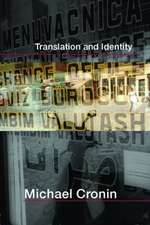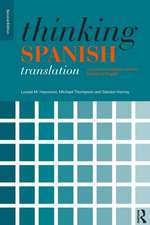Translating Song: Lyrics and Texts: Translation Practices Explained
Autor Peter Lowen Limba Engleză Paperback – 9 noi 2016
- translating songs for a range of recipients and within different contexts (skopos theory)
- translating songs for reading on paper or on screens (surtitles and subtitles)
- "singable translations" and the Pentathlon Approach
- translating expressive texts.
| Toate formatele și edițiile | Preț | Express |
|---|---|---|
| Paperback (1) | 346.96 lei 3-5 săpt. | +14.82 lei 4-10 zile |
| Taylor & Francis – 9 noi 2016 | 346.96 lei 3-5 săpt. | +14.82 lei 4-10 zile |
| Hardback (1) | 845.69 lei 6-8 săpt. | |
| Taylor & Francis – noi 2016 | 845.69 lei 6-8 săpt. |
Din seria Translation Practices Explained
-
 Preț: 303.89 lei
Preț: 303.89 lei -
 Preț: 302.17 lei
Preț: 302.17 lei -
 Preț: 265.72 lei
Preț: 265.72 lei -
 Preț: 233.92 lei
Preț: 233.92 lei -
 Preț: 280.81 lei
Preț: 280.81 lei -
 Preț: 287.68 lei
Preț: 287.68 lei -
 Preț: 309.50 lei
Preț: 309.50 lei -
 Preț: 228.76 lei
Preț: 228.76 lei -
 Preț: 289.62 lei
Preț: 289.62 lei - 18%
 Preț: 1058.65 lei
Preț: 1058.65 lei -
 Preț: 287.05 lei
Preț: 287.05 lei -
 Preț: 259.40 lei
Preț: 259.40 lei -
 Preț: 349.91 lei
Preț: 349.91 lei - 17%
 Preț: 271.43 lei
Preț: 271.43 lei -
 Preț: 279.69 lei
Preț: 279.69 lei -
 Preț: 465.91 lei
Preț: 465.91 lei - 5%
 Preț: 323.59 lei
Preț: 323.59 lei -
 Preț: 290.37 lei
Preț: 290.37 lei -
 Preț: 410.50 lei
Preț: 410.50 lei -
 Preț: 380.36 lei
Preț: 380.36 lei -
 Preț: 362.82 lei
Preț: 362.82 lei - 17%
 Preț: 246.74 lei
Preț: 246.74 lei - 17%
 Preț: 246.96 lei
Preț: 246.96 lei - 22%
 Preț: 371.87 lei
Preț: 371.87 lei -
 Preț: 443.69 lei
Preț: 443.69 lei - 13%
 Preț: 321.08 lei
Preț: 321.08 lei -
 Preț: 367.23 lei
Preț: 367.23 lei -
 Preț: 395.85 lei
Preț: 395.85 lei
Preț: 346.96 lei
Nou
Puncte Express: 520
Preț estimativ în valută:
66.40€ • 72.10$ • 55.77£
66.40€ • 72.10$ • 55.77£
Carte disponibilă
Livrare economică 01-15 aprilie
Livrare express 15-21 martie pentru 24.81 lei
Preluare comenzi: 021 569.72.76
Specificații
ISBN-13: 9781138641792
ISBN-10: 1138641790
Pagini: 140
Ilustrații: 12
Dimensiuni: 156 x 234 x 11 mm
Greutate: 0.25 kg
Ediția:1
Editura: Taylor & Francis
Colecția Routledge
Seria Translation Practices Explained
Locul publicării:Oxford, United Kingdom
ISBN-10: 1138641790
Pagini: 140
Ilustrații: 12
Dimensiuni: 156 x 234 x 11 mm
Greutate: 0.25 kg
Ediția:1
Editura: Taylor & Francis
Colecția Routledge
Seria Translation Practices Explained
Locul publicării:Oxford, United Kingdom
Public țintă
Postgraduate and UndergraduateCuprins
List of figures
Acknowledgements
1. Introduction: Song in human culture.
Songs have words and sometimes the words really matter.
2. Looking closely at the source text
What features can make songs hard to translate?
3. Translations to read: Or to otherwise accompany the performance of songs in the SL
The need to convey the verbal dimension of songs performed in the source language.
4. "Downstream" difficulties
Problems of devising the target text. What is lost in transit?
5. Singable translations (A) — like a pentathlon
The five main criteria for TTs to be sung to existing tunes.
6. Singable translations (B) — rhythm and rhyme
Two troublesome considerations
7. The pace of adaptations
The option of deviating from fidelity
Glossary
Index
Acknowledgements
1. Introduction: Song in human culture.
Songs have words and sometimes the words really matter.
2. Looking closely at the source text
What features can make songs hard to translate?
3. Translations to read: Or to otherwise accompany the performance of songs in the SL
The need to convey the verbal dimension of songs performed in the source language.
4. "Downstream" difficulties
Problems of devising the target text. What is lost in transit?
5. Singable translations (A) — like a pentathlon
The five main criteria for TTs to be sung to existing tunes.
6. Singable translations (B) — rhythm and rhyme
Two troublesome considerations
7. The pace of adaptations
The option of deviating from fidelity
Glossary
Index
Notă biografică
Peter Low is senior adjunct fellow in the School of Languages at the University of Canterbury, New Zealand, and a council member of the New Zealand Society of Translators and Interpreters. As a translator of vocal music, he has placed over 150 translations on the LiederNet Archive (www.lieder.net/lieder/), has devised surtitles for six operas, and has made singable translations of dozens of songs, both classical and popular.
Recenzii
Şebnem Susam-Saraeva, Literatures, Languages and Cultures, University of Edinburgh, UK was positive, but had some concerns about the thoroughness of the proposal and the simplistic style :
The book will be a valuable contribution to the field if it is not conceived of as a textbook for translation students on undergraduate or postgraduate courses, but more as a general ‘how-to’ book on translating songs for people with a wide range of experience in the field. The author obviously has the expertise and proficiency in translating songs to share with his peers.
He has done a very thorough response to this and addressed the concerns to the s
atisfaction of the series ed. He does have a chatty style and this needs watching, but we are building in an interim deadline for a batch of chapters for Kelly so he can keep things on track.
Johan Franzon, Department of Finnish, Finno-Ugrian and Scandinavian Studies, University of Helsinki, Finland provided a very detailed set of comments. He was also positive, affirming the growing interest in this area,:
I am personally sympathetic towards the ambitions behind the proposal of this book. If it came to my book shop, I would be the first to buy it… In my experience, the author is quite right in saying his proposed book is "unprecedented". Other people than me and Low have called song translation a surprisingly neglected field of study within translation studies. I can also personally endorse that there seems to exist a growing interest in the topic. Translation students at my university take up topics related to music and song for their exam papers – in spite of the lack of explicit study of the topic in our courses. Also, translation students and budding scholars from all over the world have contacted me, asking for advice and reading suggestions. The collection of scholarly articles dealing with the subject is growing. I continually come across Master’s Theses of all kinds and languages…dealing with either song translation or treatment of song in audiovisual translation (dubbing and subtitling). Among young people, there is a definite interest. …
but asked for more detail, more recent music examples and more precision in terminology.
Peter has addressed this in his very detailed response (see extras) and we are very keen to proceed now.
Series Editor recommendation (extracts from)
Peter Low (University of Canterbury, NZ; http://www.canterbury.ac.nz/spark/researcher.aspx?researcherid=84525) is one of the most quoted translator-scholars working in musicological translation. His "The Pentathlon Approach to Translating Songs" is arguably one of the handful of classics in the field, and as a prolific translator, he brings the perspective of the practitioner to bear. ..His proposal suggests an up-to-date treatment that plays to student familiarity and motivation, incorporating YouTube, lyricstranslate.com, translatingmusic.com, and similar platforms to (for the most part) avoid copyright. ..Almost no pedagogy for the song translator has been published, especially not this comprehensively.
…This text would not be a primary required text in all humanistic courses, but would become a standard text for all those who include lyric translation in their courses as a subdomain. A volume such as Translating Song Lyrics gives students entrée into the field via issues immediately familiar to them, as songs are part of everyone’s cultural vocabulary. .. I support this proposal for publication, as I find it to combine the accessibly functional with the theoretical-historical, and thus, like our best books, can have something for multiple audiences, however expert or inexpert.
K. Washbourne
The book will be a valuable contribution to the field if it is not conceived of as a textbook for translation students on undergraduate or postgraduate courses, but more as a general ‘how-to’ book on translating songs for people with a wide range of experience in the field. The author obviously has the expertise and proficiency in translating songs to share with his peers.
He has done a very thorough response to this and addressed the concerns to the s
atisfaction of the series ed. He does have a chatty style and this needs watching, but we are building in an interim deadline for a batch of chapters for Kelly so he can keep things on track.
Johan Franzon, Department of Finnish, Finno-Ugrian and Scandinavian Studies, University of Helsinki, Finland provided a very detailed set of comments. He was also positive, affirming the growing interest in this area,:
I am personally sympathetic towards the ambitions behind the proposal of this book. If it came to my book shop, I would be the first to buy it… In my experience, the author is quite right in saying his proposed book is "unprecedented". Other people than me and Low have called song translation a surprisingly neglected field of study within translation studies. I can also personally endorse that there seems to exist a growing interest in the topic. Translation students at my university take up topics related to music and song for their exam papers – in spite of the lack of explicit study of the topic in our courses. Also, translation students and budding scholars from all over the world have contacted me, asking for advice and reading suggestions. The collection of scholarly articles dealing with the subject is growing. I continually come across Master’s Theses of all kinds and languages…dealing with either song translation or treatment of song in audiovisual translation (dubbing and subtitling). Among young people, there is a definite interest. …
but asked for more detail, more recent music examples and more precision in terminology.
Peter has addressed this in his very detailed response (see extras) and we are very keen to proceed now.
Series Editor recommendation (extracts from)
Peter Low (University of Canterbury, NZ; http://www.canterbury.ac.nz/spark/researcher.aspx?researcherid=84525) is one of the most quoted translator-scholars working in musicological translation. His "The Pentathlon Approach to Translating Songs" is arguably one of the handful of classics in the field, and as a prolific translator, he brings the perspective of the practitioner to bear. ..His proposal suggests an up-to-date treatment that plays to student familiarity and motivation, incorporating YouTube, lyricstranslate.com, translatingmusic.com, and similar platforms to (for the most part) avoid copyright. ..Almost no pedagogy for the song translator has been published, especially not this comprehensively.
…This text would not be a primary required text in all humanistic courses, but would become a standard text for all those who include lyric translation in their courses as a subdomain. A volume such as Translating Song Lyrics gives students entrée into the field via issues immediately familiar to them, as songs are part of everyone’s cultural vocabulary. .. I support this proposal for publication, as I find it to combine the accessibly functional with the theoretical-historical, and thus, like our best books, can have something for multiple audiences, however expert or inexpert.
K. Washbourne
Descriere
This engaging step-by-step guide prescribes effective strategies and tactics for translating a wide range of songs and other vocal music, from classical to contemporary. Focusing on best practice and with a variety of language examples, the book centres on four key themes:
- translating songs for a range of recipients and within different contexts (skopos theory)
- translating songs for reading on paper or on screens (surtitles and subtitles)
- "singable translations" and the Pentathlon Approach
- translating expressive texts.







